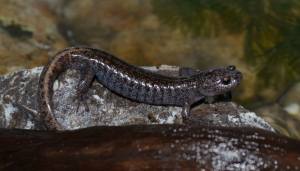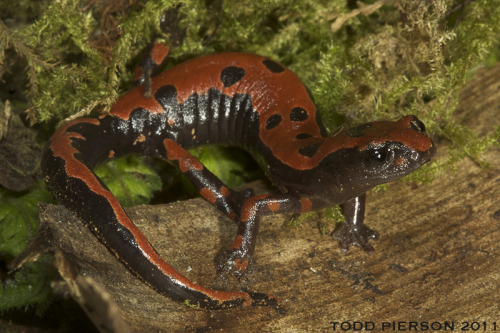#caudata
TheCalifornia giant salamander,Dicamptodon ensatus, growing up to 12 inches long, is one of North America’s largest salamanders.
photograph by Dick Bartlett (used w/ permission)
Post link

Eastern North America//Least Concern//Caudata//photo source
Fun Fact: Sirens are closely related to salamanders. They have no hind legs, and their tiny forelegs are barely visible behind their gills.
Bigfoot Splayfoot Salamander - Chiropterotriton magnipes
Chiropterotriton magnipes (Caudata - Plethodontidae), is a cave dwelling salamander known only from south-eastern San Luis Potosi and eastern Queretaro, Mexico.
These little fellows have a total length of around 80-120 mm, with the tail accounting for slightly less than half of this measurement. The head is flat and wide, with large bulging eyes. This species is unique among the splayfoot salamanders in the fullness of the wedding of its feet and because it has pad-like structures on the tips of its fingers and toes.
The Bigfoot Splayfoot Salamander is listed as Critically Endangered on the IUCN Red List; it has been seen very rarely in recent years, despite searches.
Photo credit: ©Rodrigo Villegas | Locality: not indicated (2011)
Post link
Lincoln’s Web-Footed Salamander - Bolitoglossa lincolni
Bolitoglossa lincolni (Plethodontidae) is a stout salamander with a bright coral red coloration on the back, tail, and dorsal surfaces of limbs, and sometimes the fingers and toes. It is known from the central plateau of Chiapas, Mexico, and mountainous areas of western Guatemala. It lives in low vegetation (probably including mosses), under bark, and in bromeliads, with a broad enough habitat that its populations are not declining. However, due to destruction of habitat, the species is listed as Near Threatened on the IUCN Red List.
Bolitoglossa species are able to propel themselves forward by an “explosive tail flip” that carries them off the vegetation – a protective device when in danger during its daylight resting hours. Another protective behavior is to raise its tail as an offering to a predator. If the tail is grabbed, the salamander can disarticulate and run off, leaving the predator with only the tail.
Photo credit: ©Todd Pierson (CC BY-NC-SA 2.0) | Locality: Cuchumatanes, Guatemala (2011)
Post link
Tokyo Salamander (Hynobius tokyoensis) Care Sheet

Author: Joshua S. Ralph. Establishment/Organisation: MantellaMan Conservation. First published: 21/02/16 Review date: Common name: Tokyo Salamander (Tokyo Lungless Salamander, Hynobid Salamander) Scientific name: Hynobius tokyoensis – Tago, 1931 Family: Hynobiidae Country of Origin: Japan Localities: Mainly distributed in the Fukushima Prefecture southwestwards through Tokyo to Kanagawa…
Axolotls (Ambystoma mexicanum) are neotenic amphibians, which may be related to their ability to regenerate limbs. Although very common in the pet trade, they are Critically Endangered in the wild due to habitat loss and introduced species.
Photos:Poecilia,Jan-Peter Kasper
Post link
Shiny slippery slithering friends, oh my! I had a fun time sketching amphibians with ink and my new finetec metallic pigments yesterday! Ended up playing with a little salamander-as-dragon design. Salamandragon? I love all amphibians, but there’s just a special place in my heart for the caudata fam
.
Sorry I haven’t been around a whole lot, my hand is making great progress with the physio exercises and now has three splints to help me recover – but the rest of me is falling apart like a poorly stacked jenga tower and today’s task is to learn how to pop my elbow back in (10/10 do not rec unless you’re a floppybean)
.
.
.
.
.
.
.
#sketches #sketchbook #caudata #salamander #amphibians #inkdrawing #draweveryday #drawsome #inksketch #artsy #creativity #creativeflow #carveouttimeforart #artistproblems #sketcheveryday #sketch_daily
Post link






